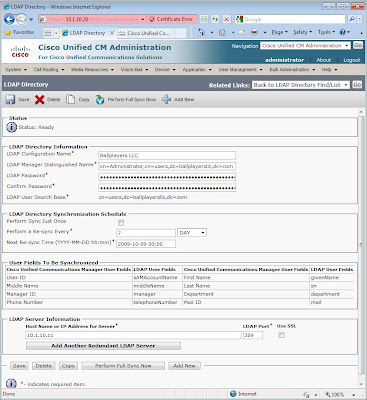CCIE Voice Lab 1.5 Tasks
1. Configure the New York voice gateway as an H.323 gateway, and register with CUCM.
2. Configure Los Angeles as an MGCP gateway. However, you cannot use the “ccm-manager config server” command. If the primary CUCM goes down, make sure all endpoints on the MGCP gateway re-register to the backup CUCM.
3. Configure PSTN connectivity for London.
4. Configure the New York voice gateway as a gatekeeper. Register the CUCM servers and London CUCME router to the gatekeeper. The CUCM servers should register with the technology prefix of “1” and the London CUCME router should register with technology prefix “2”.
5. Verify inbound calling from the PSTN.
CCIE Voice Lab 1.5 Solutions
1. First step in adding the New York VGWY to CUCM is to configure the appropriate parameters in the router, including the VWIC module and dial-plan configurations.
newyork#
!
card type t1 0 0
!
network-clock-participate wic 0
!
isdn switch-type primary-ni
!
!
voice class codec 1
codec preference 1 g722-64
codec preference 2 g711ulaw
codec preference 3 g711alaw
codec preference 4 g729r8
!
!
voice class h323 1
h225 timeout tcp establish 3
!
!
controller T1 0/0/0
cablelength long 0db
pri-group timeslots 1-3,24
!
!
!
interface FastEthernet0/0.12
description New York Voice VLAN
encapsulation dot1Q 12
ip address 10.1.12.1 255.255.255.0
h323-gateway voip interface
h323-gateway voip bind srcaddr 10.1.12.1
!
!
dial-peer voice 1 pots
description inbound PRI dial-peer
incoming called-number .
direct-inward-dial
port 0/0/0:23
!
dial-peer voice 100 voip
description Voip DialPeer to UCMSUB01
preference 1
destination-pattern 2124321...
voice-class codec 1
voice-class h323 1
session target ipv4:10.1.10.21
incoming called-number .
dtmf-relay h245-alphanumeric
!
dial-peer voice 101 voip
description Voip DialPeer to UCMPUB01
preference 2
destination-pattern 2124321...
voice-class codec 1
voice-class h323 1
session target ipv4:10.1.10.20
incoming called-number .
dtmf-relay h245-alphanumeric
!
dial-peer voice 2 pots
destination-pattern 9T
port 0/0/0:23
!
Next, add the voice gateway to CUCM. Do not forget to modify the significant digits that CUCM receives for inbound calls.

2. The instructions for adding Los Angeles as an MGCP voice gateway explicitly tell us NOT to use the the “ccm-manager config server” command. Therefore, we need to manually configure the MGCP information on the router.
losangeles#
!
card type t1 0 1
!
network-clock-participate wic 1
!
isdn switch-type primary-ni
!
!
controller T1 0/1/0
cablelength long 0db
pri-group timeslots 1-3,24 service mgcp
!
!
interface Serial0/1/0:23
no ip address
encapsulation hdlc
isdn switch-type primary-ni
isdn incoming-voice voice
isdn bind-l3 ccm-manager
no cdp enable
!
!
ccm-manager switchback immediate
ccm-manager redundant-host 10.1.10.20
ccm-manager mgcp
ccm-manager fax protocol cisco
!
mgcp
mgcp call-agent 10.1.10.21 service-type mgcp version 0.1
mgcp fax t38 ecm
mgcp bind control source-interface Vlan22
mgcp bind media source-interface Vlan22
!
mgcp profile default
!
!
!
dial-peer voice 1 pots
service mgcp
incoming called-number .
direct-inward-dial
port 0/1/0:23
!
dial-peer voice 2 pots
service mgcp
destination-pattern 9T
port 0/1/0:23
!
Next, add the router as an MGCP gateway. Again, make sure to modify the significant digits that CUCM receives for inbound calls.



3. Configuring the PSTN and Dial Peers in London is fairly straight forward. Please note, I could not configure my Adtran Atlass 550 to accept the international dial-plan (44-20-7654-3XXX). As a result, I’ve modified the Adtran to accept 20-7654-3XXX. As for the 44 international code for London, I will work around this issue later (TBD).
london#
!
card type t1 0 0
!
network-clock-participate wic 0
!
isdn switch-type primary-ni
!
!
!
controller T1 0/0/0
cablelength short 110
pri-group timeslots 1-3,24
!
!
dial-peer voice 1 pots
description inbound PRI dial-peer
incoming called-number .
direct-inward-dial
port 0/0/0:23
!
dial-peer voice 2 pots
destination-pattern 9T
port 0/0/0:23
!
4. The final gatekeeper configuration requires a little care. First, pay attention to the wording regarding the technology prefix task. Habit may be to add the “#” sign; however the task instructions state only to add a “1” or “2”. Adding the “#” would result in points lost. Also, because the New York VGWY has been added to CUCM with the 10.1.12.1 IP address, you need to use a different IP for gatekeeper.
newyork#
!
gatekeeper
zone local newyork ballplayersllc.com 1.1.1.1
zone local london ballplayersll.com
gw-type-prefix 1* gw ipaddr 10.1.10.21 1720 gw ipaddr 10.1.10.20 1720
gw-type-prefix 2* gw ipaddr 3.3.3.3 1720
no shutdown
!
london#
!
interface Loopback0
ip address 3.3.3.3 255.255.255.0
ip ospf network point-to-point
h323-gateway voip interface
h323-gateway voip id newyork ipaddr 1.1.1.1 1719
h323-gateway voip h323-id london
h323-gateway voip tech-prefix 2
!
gateway
timer receive-rtp 1200
!



newyork#sh gatekeeper endpoints
GATEKEEPER ENDPOINT REGISTRATION
================================
CallSignalAddr Port RASSignalAddr Port Zone Name Type Flags
--------------- ----- --------------- ----- --------- ---- -----
3.3.3.3 1720 3.3.3.3 63826 newyork VOIP-GW
H323-ID: london
E164-ID: 3001
E164-ID: 3002
E164-ID: 3003
E164-ID: 3004
E164-ID: 3005
E164-ID: 3333
E164-ID: 2076543001
E164-ID: 2076543002
E164-ID: 2076543003
E164-ID: 2076543004
E164-ID: 2076543005
E164-ID: 2076543333
Voice Capacity Max.= Avail.= Current.= 0
10.1.10.20 41390 10.1.10.20 32833 newyork VOIP-GW
H323-ID: trunk_to_newyork_gkpr_1
Voice Capacity Max.= Avail.= Current.= 0
10.1.10.21 36152 10.1.10.21 32821 newyork VOIP-GW
H323-ID: trunk_to_newyork_gkpr_2
Voice Capacity Max.= Avail.= Current.= 0
Total number of active registrations = 3
newyork#sh gatekeeper gw-type-prefix
GATEWAY TYPE PREFIX TABLE
=========================
Prefix: 1*
Statically-configured gateways (not necessarily currently registered):
10.1.10.21:1720
10.1.10.20:1720
Zone newyork master gateway list:
10.1.10.20:41390 trunk_to_newyork_gkpr_1
10.1.10.21:36152 trunk_to_newyork_gkpr_2
Prefix: 2*
Statically-configured gateways (not necessarily currently registered):
3.3.3.3:1720
Zone newyork master gateway list:
3.3.3.3:1720 london
5. Each location should now be able to receive inbound calls from the PSTN. However, since a dial plan has yet to be configured on CUCM, only London can dial out.










